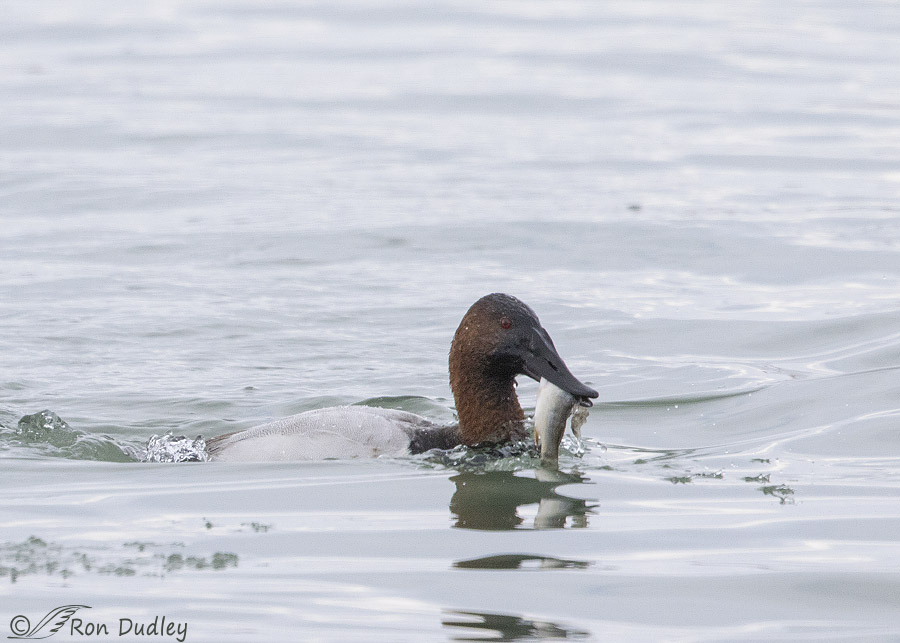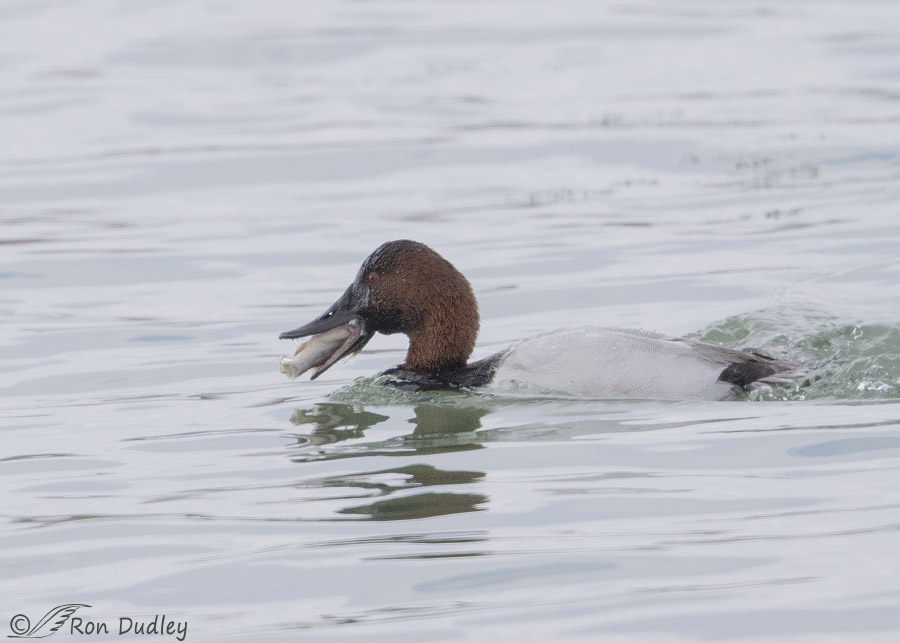A behavior I’d never heard of, seen or photographed until last week. I believe this to be a story of adaptability and survival.
Canvasbacks are omnivorous. During winter and migration their diet consists mainly of plants (aquatic buds, rhizomes and tubers) but during the breeding season they branch out a little to include insects and snails along with the plant material. Cornell’s Birds of North America Online describes their known diet in different locations and at varying times of the year in great detail (3145 words). BNA includes many dozens of specific food items of Canvasbacks by common and species name but there’s absolutely no mention of fish (or any other vertebrate for that matter).
So six days ago at Bear River MBR I was blown away when I watched and photographed a male Canvasback fight with other birds over a fish and eventually eat it.
- Note: the light was just awful that morning so these images are of poor quality but they’re good enough to document the behavior

The fish was originally in the possession of a coot but after an extended pursuit and struggle the Canvasback ended up with it. Several coots pursued the duck as it attempted to swallow the fish but their attempts at stealing it back were only half-hearted, probably because Canvasbacks are almost twice the size of coots.

The duck had an extremely difficult time swallowing the fish but it eventually got it down immediately after this photo was taken. I suspect the source of the difficulty was that Canvasback bills, mouths and throats aren’t well adapted to swallowing food items this size. I’d estimate that the duck attempted to swallow the fish about a dozen times before it finally succeeded.
This fish caused a lot of excitement that morning among bird species that don’t typically eat fish. Coots are known to eat them occasionally but a male Gadwall also tried to steal this fish from the coots and Gadwalls eating fish is almost as unusual as Canvasbacks doing the same thing.
I suspect this is a story about the value of adaptability. In the 1950’s fully one half of the entire North American population of Canvasbacks wintered on Chesapeake Bay where they fed almost exclusively on SAV (submerged aquatic vegetation). But by 1985 Canvasback numbers on Chesapeake Bay were reduced to only about 10% of their historical winter population and scientists attribute that decline to the destruction of SAV acreage caused by development and other human intrusions. But today their population has stabilized and is even increasing because by the 1970’s Canvasbacks had adapted to eating Baltic Clams which are extremely common in the bay. Clams now make up 80% of their winter diet.
So Canvasbacks survived the destruction of their major food source by being adaptable and changing their diet. Redheads, which also feed primarily on SAV tubers, have not been able to adapt so their population remains low.
Adaptability is the key to survival in a changing environment. Just ask any skunk, coyote, fox, house mouse, crow or bedbug about that.
But you can’t ask a Passenger Pigeon for obvious reasons.
Ron


Thanks for all the great pictures in 2017, Ron. ….Hope 2018 is a good year for you.
Thanks very much, Howard. I wish you the same for 2018.
Food is food when you have to survive. When I was in China in 1986 I ate things I never thought of putting in my mouth. I wasn’t starving but I was visiting a culture who had to survive years of starvation. They made many things inedible rather tasty!
I’ve heard about some of those things the Chinese eat. Not for me!
I almost forgot! I’m wishing everyone here a very Happy, Healthy and Abundant New Year! Y’all have graced and blessed my life for the last year and I’m so very grateful to each and every one of you!
And Ron, a) thank you for your wide-ranging teachings, b) your dedication to ethics and personal integrity (that’s a HUGE biggie for me), c) your humor, d) your ability to work with cameras, e) your dedication to exploring The Great Out There and finding all kinds of new things we haven’t known before, f) for sharing the sheer beauty of this spinning rock and its inhabitants, and f) just thanks for everything you do!! And that goes for Mia, too!
Y’all ROCK!!
Those are some very kind words, Laura. Thank you!
You know those words wouldn’t have found their way into print if they weren’t true! You and Mia ROCK!
The New Year has landed here and, as usual, your blog is my first of the day. There I am NOT adaptable.
Thank you so much for broadening my education again.
I am very glad to hear that the adaptable canvasback not only survives but thrives.
Happy birdfilled Year to you Ron. And, as always, thank you.
Is it already 2018 on your side of the planet?
It is. Coming up for 6am. And shortly I will be out in the garden. Where the birds are already clamouring for breakfast.
YAY EC! I don’t think it matters much one way or the other, but I’m ready to say BubBYE to 2017!
Yeah, my outside birds clamored for their food this morning, too. They’re cheeky little devils, aren’t they! And every evening, the house bunnies are out there waiting to be fed. Just two indications that I’m the servant around here. It’s a good job. I like it
EC, I thought of you at 5AM this morning when I saw that CNN said that your Aussie New Year had already begun. May it be a great one for you!
Just goes to prove we don’t know what we don’t know Not even BNA knows this and you’ve been photographing a lot of things we didn’t know this year. And that goes to prove that you don’t know what you’re going to see when you regularly get out into The Great Out There! LOL!
Not even BNA knows this and you’ve been photographing a lot of things we didn’t know this year. And that goes to prove that you don’t know what you’re going to see when you regularly get out into The Great Out There! LOL!
And that said, I have several items I will NOT eat–okra, liver and grits top that list. HOWEVER, I’ll just bet you that if I were starving and there was a bowl of liver and grits with okra on the table, I’d chow down in a heartbeat! And I’d probably chow down with a beef tongue appetizer, too. Starvation changes folks.
And thank you for expanding my duck ID skills!
No grits, Laura? Say it ain’t so! After our crawfish discussions, I thought we were culinary sisters. My mom used to make the best tongue too — she’d corn it like a beef brisket. And my grandfather’s chopped liver was the best. I’m with you on the okra though — filé all the way!
My mom used to make the best tongue too — she’d corn it like a beef brisket. And my grandfather’s chopped liver was the best. I’m with you on the okra though — filé all the way!
LOL Marty!! I make a MEAN crawfish etoufe, but grits, NOPE, not gonna happen again Well, not unless that starvation thing happens…then, I’ll reconsider my position on a lot of things. As long as I can operate as a falconer, that shouldn’t happen. But you never know!
Well, not unless that starvation thing happens…then, I’ll reconsider my position on a lot of things. As long as I can operate as a falconer, that shouldn’t happen. But you never know!
Jack was pretty thankful to have me around yesterday. He caught his rabbit, BUT he was so entangled in the mesquite that I had to cut a lot of the dead stuff away to get him (and his bunny) out of there! He’s getting good at these baseball base slides, and I’m thankful he wasn’t in a cactus yesterday!! LOL! I’m still pulling them out of my hands and I haven’t yet tackled my jeans and hoodie from the first cactus adventure.
Laura, I’ve never eaten grits and I’d have to be pretty damned hungry to try okra again. Liver’s ok when it’s fixed right but it’s been years since I’ve eaten any.
Like under cooked cream of wheat to me – no thanks!
Some people like that stuff and that’s OK. They can have all of my portions. I’ll sacrifice it gladly (under current non-starvation conditions, of course). LOL!
Oatmeal, cream of wheat, okra….YUK!!! (slimey and gross!!!)..I’d rather eat voles…..liver, onions,and ketchup– Ok. Grits with butter, salt and pepper, and bacon, also OK…
Patty, I’ll send you some voles so you can dine on them with your liver and grits in the morning. Jack says they’re yummy, so don’t tell him I’m raiding his stash!
Really interesting! I just never know what I get to learn when I come to your digital classroom, Ron! He’s quite the handsome boy too. I feel a little sorry for the coot that lost its breakfast, though. That interaction must have been a sight to see.
He’s quite the handsome boy too. I feel a little sorry for the coot that lost its breakfast, though. That interaction must have been a sight to see.
It was a sight to see, Marty. It lasted for a long time and involved many birds of at least three different species. I just wish I’d had better light!
Fascinating! I hope you will send these photos and location info to the folks at Cornell.
Thanks, Nancy. I’ve mentioned before that I no longer send info/photos to Cornell (BNA) because even when they initially express interest they just end up ignoring them. I’m afraid it’s become a waste of my time.
That is a real shame! I have seen one or two webcam owners who have not learned the lessons that their own cams are teaching the rest of us, but for Cornell to ignore documented evidence is truly wasteful on their part.
I agree, Nancy. I was saddened to be disappointed in them because I’m a huge fan of BNA. But disappointed I am.
Science-based, “Nature Expert”, and Clinical pomposity is a real pain in the butt….too darned much of it….especially with animal behavior and especially when documented with videos, photos and actual experience….chaps my behind!!!
I learned some more new things from you today! Happy New Year to you and Family, and may the year 2018 bring you Good Luck, and all your photos be the best yet.
Thanks, Trudy. Learning is always a good thing.
I can’t quite wrap my head around a duck eating a clam…I woukd expect the clam to clamp closed its shell…and then what???
Gulls drop clams onto the rocks to open them then eat the soft clam meat inside…but can’t imagine how a duck can eat things with shells—like a clam….
Patty – these clams are very small, less than 1/2″ in diameter. I’d assume that after they’re swallowed and the clam dies its adductor muscle would relax which would open the shell and allow digestion to commence.
Absolutely fascinating that this is a species that can adapt so well. I’m glad you got to see the behavior and document it.
Susan, I hope there are more species out there that adapt just as well or even better. They’re going to need that ability very soon I’m afraid…
Interesting! The canvasback certainly got the job done even if it was a struggle! The fish must agree with their digestive system and provide needed nutrients….. Glad you captured the behavior.
Me too, Judy. Thanks.